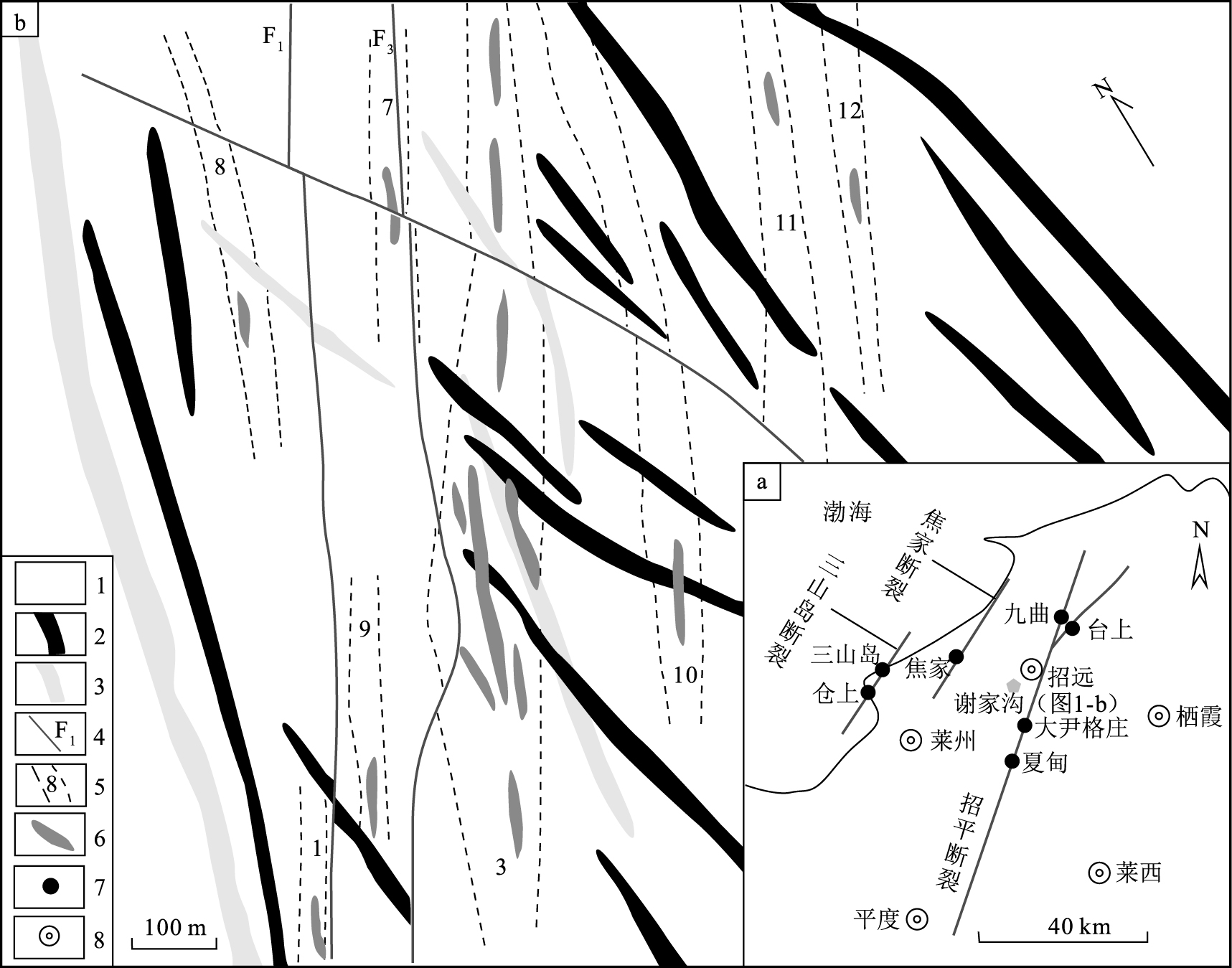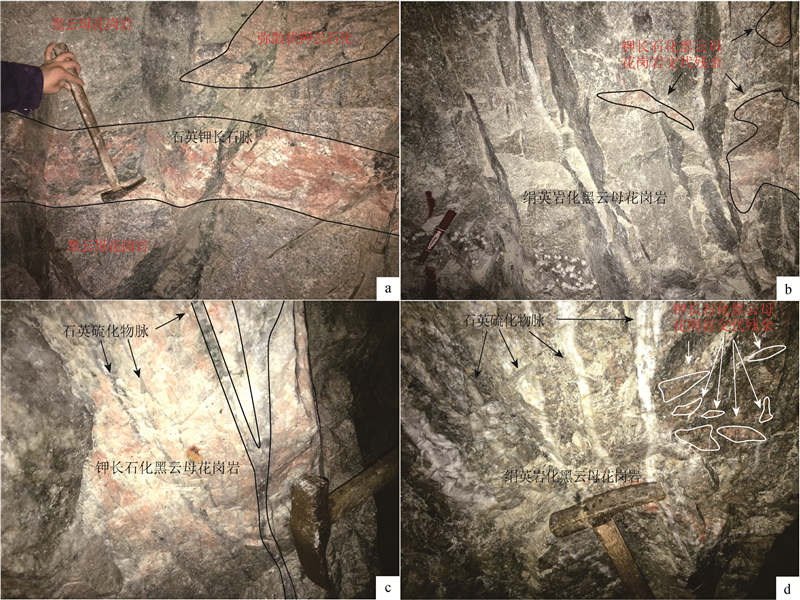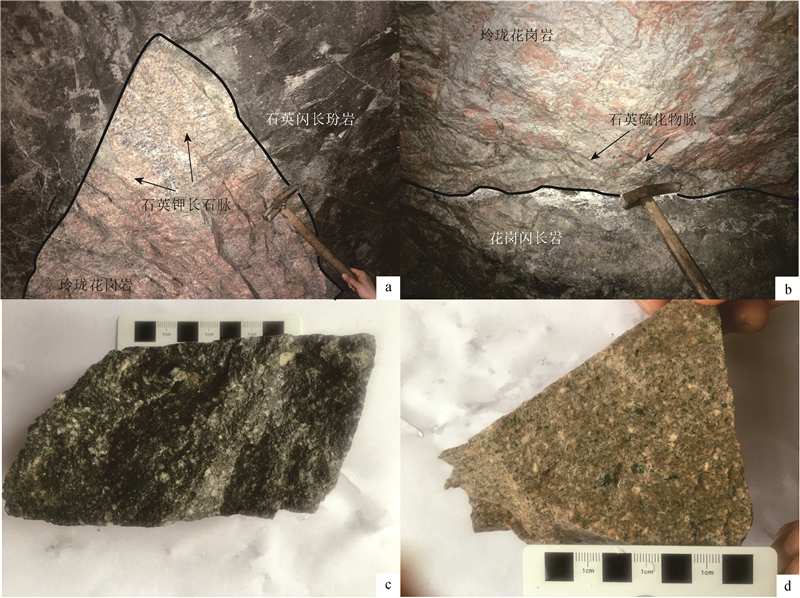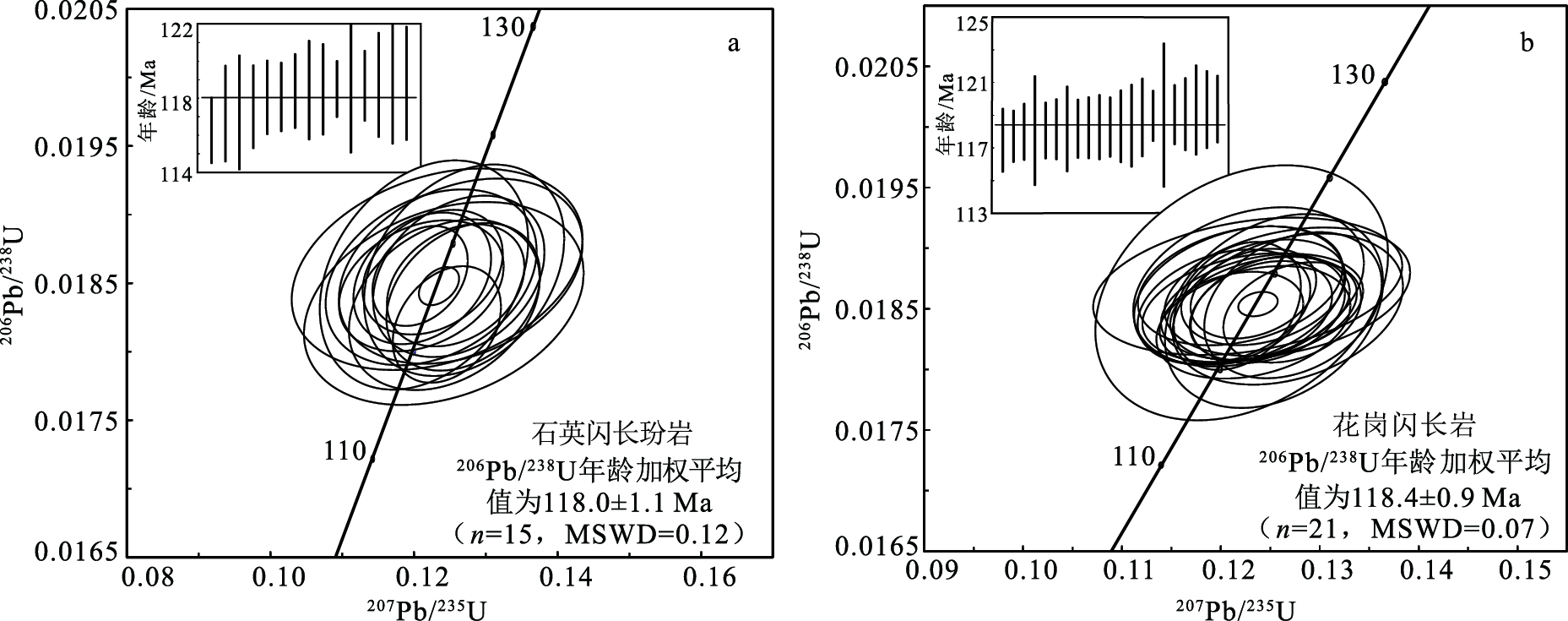U-Pb age of post-ore dykes in the Xiejiagou gold deposit and its constraints on ore-forming age, Northwest Jiaodong, China
-
摘要:
胶西北地区是中国最大的金矿集区之一,金资源储量超过4500 t,金矿床受三山岛、焦家、招平3条断裂带及其分支断裂控制明显。谢家沟金矿位于招平断裂带的西侧,与区域上产于招平主干断裂的大尹格庄、夏甸等矿床不同,该矿床产出于主干断裂带的下盘,矿体与次一级的北北东向、北北西向断裂构造关系密切。基于坑道中发现的石英闪长玢岩和花岗闪长岩岩脉切割矿化蚀变现象,对2套岩脉进行U-Pb定年,获得其结晶年龄分别为118.0±1.1 Ma和118.4±0.9 Ma,确定了谢家沟金成矿作用的时间下限,指示区域上金成矿作用在118 Ma基本结束。推测区域成矿与郭家岭岩体形成之后、伟德山岩体形成之前的闪长类岩体关系密切。
-
关键词:
- 胶西北 /
- 谢家沟 /
- 金矿 /
- LA-ICP-MS锆石U-Pb测年
Abstract:The northwest Jiaodong peninsula is one of the largest gold ore concentration areas in China, in which gold resource reserves exceed 4000 tons.Most of the deposits in the area are controlled by Sanshandao, Jiaojia and Zhaoping faults.The Xiejiagou gold deposit is located in the west and the footwall of Zhaoping fault, controlled by NWW- and NEE- secondary faults, which is different from the feature of the deposits which occur in Zhaoping fault such as Dayinggezhuang and Xiadian.Based on the phenomenon of existence of two kinds of dike, i.e., quartz diorite porphyry and granodiorite, which cut though mineralization and alteration in the tunnel, the authors conducted LA-ICP-MS U-Pb dating for the dikes.It is found that the U-Pb ages are 118.0±1.1 Ma and 118.4±0.9 Ma respectively, which suggests that the lower limit age of mineralization is 118 Ma in the Xiegagou gold deposit, and gold mineralization in northwest area of Jiaodong peninsula had been mainly completed by 118 Ma.It is inferred that regional mineralization was more probably related to diorite type intrusives between the formation of Guojialing and Weideshan intrusives.
-
Keywords:
- Northwest Jiaodong /
- Xiejiagou /
- gold deposit /
- LA-ICP-MS zircon U-Pb dating
-
区域地质调查和填图是地质工作的基础,也是衡量一个国家基础地质调查和研究程度及水平的重要指标,具有重要的战略意义。中国地质调查局高度重视基础地质调查与填图方式、方法的改革,树立“地质填图的过程就是科学研究的过程”的理念,确定“需求决定工作部署”、“问题决定调查方式”的工作思路,提升解决制约重大资源环境的基础地质问题和地球系统科学问题的能力。在中国地质调查局总工室和基础部的协调、领导下,由中国地质科学院地质研究所、地质力学所联合地调局六大区域地质调查中心开展了国际分幅和非国际分幅的中大比例尺专题试点填图,取得了重要进展。这是中国第一次较系统地构建填图方法体系。2019年11月6—7日,中国地质调查局召开了第三次全国区域地质调查工作会议。同时,成立了全国区域地质调查专家委员会,并组织了全国区调填图方法研讨会,来自全国地质行业近100人参加了培训和研讨,有30人在会议上交流发言,展现了区调改革在技术方法上的创新及取得的一批新进展、新发现,收效良好。
本专辑是本次会议成果的一次体现。本专辑共收录15篇论文,内容涉及短周期密集台阵方法在专题填图中的运用、遥感技术的使用等,以及地层、岩浆岩(侵入岩和火山岩)、变质岩、蛇绿混杂岩、构造、古生物、矿床等基础学科填图成果;还有论文,包括岩溶地区填图方法和地貌演变、造山带构造变形、侵入岩、蛇绿混杂岩、年轻变质事件及热泉的填图成果介绍,将在下一辑发表。这些论文集中展示了填图的成果。
(1)地球物理方法在填图中的运用。新填图方法和理念的运用是现代填图的重要内容,卢占武等介绍了利用短周期密集台阵进行近地表结构调查的应用实例,提出了该技术在专题地质填图中的应用前景,丰富和完善了专题填图的技术方法体系。李娜等介绍了高光谱遥感技术在中国西部基岩区填图中的应用,高光谱遥感数据对不同岩性段和岩相带、细小构造等区分能力突出,提高了地质调查填图的效率和质量。
(2)蛇绿混杂岩填图。蛇绿混杂岩的填图历经数十年的探索,也是造山带研究的基础数据来源,王国强等系统介绍了近十余年来北山造山带关键地段1:5万区域地质调查和综合研究成果,突出了造山带蛇绿混杂岩带填图方法在北山地区的实践和应用。付长垒等在大比例尺填图的基础上,在拉脊山识别出连续的洋岛海山火山-沉积组合序列,为造山带古洋盆构造演化研究提供了新思路。
(3)侵入岩区填图。侵入岩是造山带的重要组成部分,对它们的刻画和研究一直是造山带研究的基础性工作。苑新晨等对滇西澜沧江地区南段复式岩基进行研究,确定其是古特提斯封闭及保山-思茅地块碰撞的响应。卢鹏等在前期开展同位素填图的基础上,在东准噶尔乌伦古河地区识别出一套晚古生代富碱细晶花岗质岩墙,这期岩墙在整个中亚造山带中普遍发育,具有重要的构造环境指示意义。车亚文等在1:5万填图的基础上,对大兴安岭南段林西地区辉长闪长岩开展系统工作,确定其与蒙古-鄂霍茨克洋闭合引起的碰撞后伸展背景有关。王帅等报道了1:5万填图发现的迪彦庙SSZ型蛇绿岩北部晚石炭世马尼塔埃达克岩,确定其为洋内俯冲岩石组合的重要组成部分,表明古亚洲洋东段在晚石炭世处于洋内俯冲消减过程中。
(4)沉积岩区填图。沉积岩区填图是建立地层系统与格架、恢复区域和生命演化的重要手段。向忠金等通过对中越边界富宁—那坡地区的1:5万填图,查明早—中三叠世火山岩及其相关沉积序列,确定了扬子南缘地区印支期岛弧火山-沉积环境。石秋圆等报道了新建立的中—上三叠统卡尼阶岩石地层单位——嘎热扎地组,该工作填补了措勤中—上三叠统卡尼阶岩石地层单位的空白。安显银等报道了在西藏察雅地区侏罗纪红层中发现的恐龙化石,丰富了侏罗系恐龙的地理分布,有助于了解亚洲地区蜥脚类和兽脚类恐龙的早期演化和分异。
(5)变质岩区填图。变质岩填图是填图的难点,也是获得突破和新发现的主要基础。李猛等对东昆仑西段金水口岩群白沙河岩组的碎屑锆石进行研究,指出东昆仑早古生代可能存在一条近千千米的高压变质岩带。张连祥等通过莱阳地区1:5万变质基底填图,限定了胶北荆山群禄格庄组的原岩为古元古代,推测粉子山群小宋组与祝家夼组沉积时可能靠近被动大陆边缘的一侧,而禄格庄组更靠近岩浆岛弧的一侧,二者可能属于同时异相沉积的产物。
(6)复杂构造区填图。构造地质是中国填图中最薄弱的环节,复杂现象和关系的识别及构造过程的建立得益于详细地地质填图。张北航等在1:5万填图的基础上,厘定出狼山地区自晚侏罗世以来发育6期陆内变形,并认为先存构造和欧亚板块边缘自晚侏罗世以来不同方向的增生是控制狼山地区陆内变形的主要因素。柯昌辉等通过对白云鄂博矿田内褶皱及断层构造特征的剖析,确定了中元古代—晚古生代4期构造活动,对矿区深部及外围找矿工作具有重要的指导意义。
本专辑的文章是填图试点的部分成果及方法探索,希望能够为今后进一步开展中大比例尺(1:5万和1:2.5万)区域地质填图和专题填图起到推广和借鉴作用,成功的经验和失败的教训都是未来继续工作不可多得的财富。希望专辑中介绍的新方法、新理念能够逐步为广大一线工作认可,并运用到新时期地质调查工作中。
张 进 王 涛
中国地质科学院地质研究所
2020年12月20日
致谢: 感谢招金集团金亭岭矿业公司为野外工作提供便利条件,感谢中国科学院地质与地球物理研究所范宏瑞研究员和审稿专家提出的建设性意见和建议。 -
图 1 谢家沟金矿地质简图(据参考文献[24]修改)
1—玲珑花岗岩;2—中基性脉岩;3—硫铁矿带;4—断层及编号;5—蚀变带及编号;6—金矿体;7—金矿床;8—城市
Figure 1. Sketch geological map of the Xiejiagou gold deposit
表 1 石英闪长玢岩和花岗闪长岩LA-ICP-MS锆石U-Th-Pb同位素测定结果
Table 1 LA-ICP-MS zircon U-Th-Pb data of quartz diorite porphyry and granodiorite
测点
编号含量/10-6 Th/U 同位素比值 年龄/Ma 206Pb 232Th 238U 207Pb/206Pb 1σ 206Pb/238U 1σ 207Pb/235U 1σ 206Pb/238U 1σ 石英闪长玢岩XJG-GS-1 1 1.28 56.80 69.11 0.82 0.05 0.01 0.02 0.00 0.13 0.01 118.7 2.8 3 2.02 107.13 111.62 0.96 0.05 0.00 0.02 0.00 0.12 0.01 117.2 2.6 5 1.52 70.61 85.34 0.83 0.05 0.00 0.02 0.00 0.13 0.01 118.1 1.9 6 1.16 68.62 63.52 1.08 0.05 0.01 0.02 0.00 0.12 0.01 118.8 3.1 8 1.08 58.89 60.60 0.97 0.05 0.00 0.02 0.00 0.12 0.01 118.0 2.0 9 0.91 45.41 51.53 0.88 0.05 0.00 0.02 0.00 0.12 0.01 118.4 2.7 10 1.28 66.79 74.10 0.90 0.05 0.00 0.02 0.00 0.12 0.01 118.5 3.5 11 1.78 127.51 98.75 1.29 0.05 0.00 0.02 0.00 0.13 0.01 117.5 2.3 12 1.35 70.91 73.81 0.96 0.05 0.00 0.02 0.00 0.12 0.01 118.7 1.9 13 1.32 67.31 73.18 0.92 0.05 0.00 0.02 0.00 0.13 0.01 118.5 2.5 15 2.15 155.28 119.89 1.30 0.05 0.00 0.02 0.00 0.12 0.01 118.4 2.0 16 1.38 68.83 74.74 0.92 0.05 0.01 0.02 0.00 0.12 0.01 117.2 3.1 17 2.24 103.32 122.85 0.84 0.05 0.00 0.02 0.00 0.12 0.00 118.5 1.5 19 1.89 91.20 107.63 0.85 0.05 0.00 0.02 0.00 0.12 0.00 116.3 1.8 21 1.29 86.20 76.68 1.12 0.05 0.00 0.02 0.00 0.13 0.01 118.8 3.2 花岗闪长岩XJG-GS-2 2 1.15 56.09 63.89 0.88 0.05 0.00 0.02 0.00 0.12 0.01 118.3 1.8 3 1.99 123.79 108.63 1.14 0.05 0.00 0.02 0.00 0.12 0.01 119.4 2.1 4 1.63 78.09 88.55 0.88 0.05 0.00 0.02 0.00 0.12 0.01 119.3 2.7 6 1.53 76.97 83.73 0.92 0.05 0.00 0.02 0.00 0.12 0.01 118.2 1.9 7 1.10 60.58 61.13 0.99 0.05 0.01 0.02 0.00 0.12 0.01 119.0 4.4 8 4.79 291.47 261.54 1.11 0.05 0.00 0.02 0.00 0.12 0.01 118.1 1.8 9 1.41 65.22 77.77 0.84 0.05 0.00 0.02 0.00 0.12 0.01 119.3 2.4 10 2.17 123.58 119.68 1.03 0.05 0.00 0.02 0.00 0.12 0.01 119.0 1.8 11 1.46 93.02 81.28 1.14 0.05 0.00 0.02 0.00 0.12 0.01 118.9 2.4 12 2.79 145.66 151.55 0.96 0.05 0.00 0.02 0.00 0.13 0.01 118.2 2.6 13 4.28 279.43 236.29 1.18 0.05 0.00 0.02 0.00 0.13 0.00 118.0 1.7 14 2.18 137.79 119.17 1.16 0.05 0.00 0.02 0.00 0.12 0.01 118.2 1.8 17 1.56 94.58 87.20 1.08 0.05 0.00 0.02 0.00 0.12 0.01 118.3 2.0 18 2.40 153.05 134.54 1.14 0.05 0.00 0.02 0.00 0.12 0.00 117.7 1.6 19 2.76 128.33 157.31 0.82 0.05 0.00 0.02 0.00 0.13 0.01 118.4 2.5 20 1.71 89.53 97.90 0.91 0.05 0.00 0.02 0.00 0.12 0.01 117.5 1.9 21 4.21 217.62 233.61 0.93 0.05 0.00 0.02 0.00 0.12 0.00 119.0 1.6 22 1.99 150.06 117.70 1.27 0.05 0.00 0.02 0.00 0.13 0.01 118.1 3.3 23 5.09 308.27 290.86 1.06 0.05 0.00 0.02 0.00 0.12 0.00 118.3 2.2 24 1.28 66.46 71.45 0.93 0.05 0.00 0.02 0.00 0.13 0.01 119.1 2.2 25 3.00 119.75 168.91 0.71 0.05 0.00 0.02 0.00 0.12 0.00 118.1 1.7 -
宋明春.胶东金矿深部找矿主要成果和关键理论技术进展[J].地质通报, 2015, 34(9):1758-1771. http://dzhtb.cgs.cn/gbc/ch/reader/view_abstract.aspx?file_no=20150917&flag=1 杨立强, 邓军, 王中亮, 等.胶东中生代金成矿系统[J].岩石学报, 2014, 30(9):2447-2467. http://www.wanfangdata.com.cn/details/detail.do?_type=perio&id=ysxb98201409001 宋明春, 崔书学, 姜洪利.山东胶西北矿集区和焦家金矿田成矿构造系统[J].地质通报, 2011, 30(4):573-578. http://dzhtb.cgs.cn/gbc/ch/reader/view_abstract.aspx?file_no=20110413&flag=1 Yang J H, Wu F Y, Wilde S A.A review of the geodynamic setting of large-scale Late Mesozoic gold mineralization in the North China Craton:An association with lithospheric thinning[J].Ore Geology Reviews, 2003, 23:125-152 doi: 10.1016/S0169-1368(03)00033-7
范宏瑞, 胡芳芳, 杨进辉, 等.胶东中生代构造体制转折过程中流体演化和金的大规模成矿[J].岩石学报, 2005, 21(5):1317-1328. http://www.wanfangdata.com.cn/details/detail.do?_type=perio&id=ysxb98200505001 范宏瑞, 冯凯, 李兴辉, 等.胶东-朝鲜半岛中生代金成矿作用[J].岩石学报, 2016, 32(10):3225-3238 http://www.wanfangdata.com.cn/details/detail.do?_type=perio&id=ysxb98201610021 朱日祥, 范宏瑞, 李建威, 等.克拉通破坏型金矿床[J].中国科学:地球科学, 2015, 45(8):1153-1168. http://www.cnki.com.cn/Article/CJFDTotal-JDXK201508006.htm Fan H R, Zhai M G, Xie Y H, et al.Ore-forming fluids associated with granite-hosted gold mineralization at the Sanshandao deposit, Jiaodong gold province, China[J].Mineral Deposita, 2003, 38(6):739-750. doi: 10.1007/s00126-003-0368-x
Yang L, Deng J, Jing Z, et al.Decrepitation thermometry and compositions of fluid inclusions of the Damoqujia gold deposit, Jiaodong Gold Province, China:implications for metallogeny and exploration[J].Journal of China University of Geosciences, 2008, 19(4):378-390. doi: 10.1016/S1002-0705(08)60071-0
Hu F F, Fan H R, Jiang X H, et al.Fluid inclusions at different depths in the Sanshandao gold deposit, Jiaodong Peninsula, China[J].Geofluids, 2013, 13(4):528-541. doi: 10.1111/gfl.12065
Wang C, Deng J, Santosh M, et al.Timing, tectonic implications and genesis of gold mineralization in theXincheng gold deposit, China:C-H-O isotopes, pyrite Rb-Sr and zircon fission track thermochronometry[J].Ore Geology Reviews, 2015, 65:659-673. doi: 10.1016/j.oregeorev.2014.04.022
Wen B J, Fan H R, Santosh M, et al.Genesis of two different types of gold mineralization in the Linglong gold field, China:Constrains from geology, fluid inclusions and stable isotope[J].Ore Geology Reviews, 2015, 65:643-658. doi: 10.1016/j.oregeorev.2014.03.018
Cai Y C, Fan H R, Santosh M, et al.Decratonic gold mineralization:Evidence from the Shangzhuang gold deposit, eastern North China Craton[J].Gondwana Research, 2018, 54:1-22. doi: 10.1016/j.gr.2017.09.009
Yang L Q, Deng J, Guo L N, et al.Origin and evolution of ore fluid, and gold-deposition processes at the giant Taishang gold deposit, Jiaodong Peninsula, eastern China[J].Ore Geology Reviews, 2016, 72:585-602. doi: 10.1016/j.oregeorev.2015.08.021
Wang Z L, Yang L Q, Deng J, et al.Gold-hosting high Ba-Sr granitoids in the Xincheng gold deposit, Jiaodong Peninsula, East China:Petrogenesis and tectonic setting[J].Journal of Asian Earth Sciences, 2014, 95:274-299. doi: 10.1016/j.jseaes.2014.03.001
邱连贵, 任凤楼, 曹忠祥, 等.胶东地区晚中生代岩浆活动及对大地构造的制约[J].大地构造与成矿学, 2008, 32(1):117-123. http://www.wanfangdata.com.cn/details/detail.do?_type=perio&id=ddgzyckx200801015 王世进, 张成基.山东省侵入岩期次划分及岩石单位代号的厘定[J].山东国土资源, 2009, 25(1):22-24. http://www.wanfangdata.com.cn/details/detail.do?_type=perio&id=sddz200901010 宋明春, 伊丕厚, 崔书学, 等.胶东金矿"热隆伸展"成矿理论及其找矿意义[J].山东省国土资源, 2013, 29(7):1-12. http://d.wanfangdata.com.cn/periodical/sddz201307001 宋明春, 艾宪森, 于学峰, 等.山东省矿产资源类型和时空分布特点[J].矿床地质, 2015, 34(6):1237-1254. http://www.wanfangdata.com.cn/details/detail.do?_type=perio&id=kcdz201506012 辛洪波, 邓军, 曲晓明, 等.胶东谢家沟金矿床地质特征与成矿时代研究[J].黄金科学技术, 2006, 14(3):1-6. http://www.wanfangdata.com.cn/details/detail.do?_type=perio&id=hjkxjs200603001 Ma W D, Fan H R, Liu X, et al.Hydrothermal fluid evolution of the Jintingling gold deposit in the Jiaodong peninsula, China:constraints from U-Pb age, CL imaging, fluid inclusion and stable isotope[J].Journal of Asian Earth Science, 2018, 160:287-303. doi: 10.1016/j.jseaes.2017.12.033
辛洪波.胶东谢家沟金矿与焦家金矿地质特征与成因对比[D].中国地质大学(北京)博士学位论文, 2005. 邓军, 王建国, 韦延光, 等.山东谢家沟金矿床矿石与金矿物特征[J].地球科学—中国地质大学学报, 2007, 32(3):373-380. http://www.wanfangdata.com.cn/details/detail.do?_type=perio&id=dqkx200703010 王建国, 刘洪臣, 邓军, 等.胶东谢家沟金矿稀土元素特征及其成矿意义[J].地质学报, 2009, 83(10):1497-1504. http://www.wanfangdata.com.cn/details/detail.do?_type=perio&id=dizhixb200910014 Zong K Q, Liu Y S, Gao C G, et al.In situ U-Pb dating and trace element analysis of zircons in thin sections of eclogite:refining constraints on the UHP metamorphism of the Sulu terrane, China[J].Chemical Geology, 2010, 269:237-251. doi: 10.1016/j.chemgeo.2009.09.021
Corfu F, Hanchar J M, Hoskin P W O, et al.Atlas of Zircon Textures[J].Reviews in Mineralogy & Geochemistry, 2003, 53(1):469-500. https://pubs.geoscienceworld.org/msa/rimg/article-abstract/53/1/469/87484/Atlas-of-Zircon-Textures
吴元保, 郑永飞.锆石成因矿物学研究及其对U-Pb年龄解释的制约[J].科学通报, 2004, 49(16):1589-1604. http://www.wanfangdata.com.cn/details/detail.do?_type=perio&id=kxtb200416002 毛景文, 张作衡, 余金杰, 等.华北及邻区中生代大规模成矿的地球动力学背景:从金属矿床年龄精测得到启示[J].中国科学:地球科学, 2003, 33(4):289-299. http://d.wanfangdata.com.cn/periodical/zgkx-cd200304001 Zhang X, Cawood P A, Wilde S A, et al.Geology and timing of mineralization at the Cangshang gold deposit, north-western Jiaodong Peninsula, China[J].Mineralium Deposita, 2003, 38(2):141-153. doi: 10.1007/s00126-002-0290-7
Bi S J, Zhao X F.40Ar/ 39Ar dating of the Jiehe gold deposit in the Jiaodong Peninsula, eastern North China Craton:Implications for regional gold metallogeny[J].Ore Geology Reviews, 2017, 86:639-651. doi: 10.1016/j.oregeorev.2017.03.027
Yang L Q, Guo L N, Wang Z L, et al.Timing and mechanism of gold mineralization at the Wang'ershan gold deposit, Jiaodong Peninsula, eastern China[J].Ore Geology Reviews, 2016, 88:491-510. http://www.wanfangdata.com.cn/details/detail.do?_type=perio&id=86fd22fe1d0aa5cfd99b9b6591c385fe
李厚民, 毛景文, 沈远超, 等.胶西北东季金矿床钾长石和石英的Ar-Ar年龄及其意义[J].矿床地质, 2003, 22(1):72-77. http://www.wanfangdata.com.cn/details/detail.do?_type=perio&id=kcdz200301008 Yang L Q, Deng J, Goldfarb R J, et al.40Ar/39Ar geochronological constraints on the formation of the Dayingezhuang gold deposit:New implications for timing and duration of hydrothermal activity in the Jiaodong gold province, China[J].Gondwana Research, 2014, 25(4):1469-1483. doi: 10.1016/j.gr.2013.07.001
Qiu L L, Chen F, Yang J H, et al.Single grain pyrite Rb-Sr dating of the Linglong gold deposit, eastern China[J].Ore Geology Reviews, 2008, 34(3):263-270. doi: 10.1016/j.oregeorev.2007.10.003
Yang J H, Zhou X H.Rb-Sr, Sm-Nd, and Pb isotope systematics of pyrite:implications for the age and genesis of lode gold deposits[J].Geology, 2001, 29(8):711-714. doi: 10.1130/0091-7613(2001)029<0711:RSSNAP>2.0.CO;2
翟裕生, 姚书振, 蔡克勤.矿床学(第三版)[M].北京:地质出版社, 2011. Zhou T H, Lu G.Tectonics, granitoids and Mesozoic gold depositsin East Shandong, China[J].Ore Geology Reviews, 2000, 16:71-90. doi: 10.1016/S0169-1368(99)00023-2
Goldfarb R J, Groves D I, Gardoll S.Orogenic gold and geologic time:a global synthesis[J].Ore Geology Reviews, 2001, 18(1):1-75. https://www.sciencedirect.com/science/article/pii/S0169136801000166
Goldfarb R J, Baker T, Dube B, et al.Distribution, character and genesis of gold deposits in metamorphic terranes[C]//Economic Geology 100 th Anniversary Volume, 2005: 407-450.
Goldfarb R J, Hart C J R, Davis G, et al.East Asian gold:Deciphering the anomaly of Phanerozoic gold in Precambrian cratons[J].Economic Geology, 2007, 102(3):341-346 doi: 10.2113/gsecongeo.102.3.341
翟明国, 范宏瑞, 杨进辉, 等.非造山带型金矿-胶东型金矿的陆内成矿作用[J].地学前缘, 2004, 11(1):85-98 http://www.wanfangdata.com.cn/details/detail.do?_type=perio&id=dxqy200401005 Zorin Y A.Geodynamics of the western part of the Mongolia-Okhotsk collisional belt, Trans-Baikal region (Russia) andMongolia[J].Tectonophysics, 1999, 306(1):33-56. doi: 10.1016/S0040-1951(99)00042-6
Brian J D, Gregory A D, Zhang X H, et al.The newly discovered Waziyu metamorphic core complex, Yiwulü Shan, western Liaoning Province, North China[J].Earth Science Frontiers, 2004, 11:143-155. http://www.wanfangdata.com.cn/details/detail.do?_type=perio&id=dxqy200403016
Lin W, Faure M, Moni P, et al.Mesozoicextensional tectonics in Eastern Asia:the south Liaodong Peninsula metamorphic core complex (NE China)[J].The Journal of Geology, 2008, 116(2):134-154. https://hal-insu.archives-ouvertes.fr/file/index/docid/362879/filename/WeiLin-TheJournalofGeology-2008.pdf
朱光, 胡召齐, 陈印, 等.华北克拉通东部早白垩世伸展盆地的发育过程及其对克拉通破坏的指示[J].地质通报, 2008, 27(10):1594-1604. http://dzhtb.cgs.cn/gbc/ch/reader/view_abstract.aspx?file_no=20081002&flag=1 刘俊来, 纪沫, 申亮, 等.辽东半岛早白垩世伸展构造组合、形成时代及区域构造内涵[J].中国科学:地球科学, 2011, (5):618-637. http://www.wanfangdata.com.cn/details/detail.do?_type=perio&id=zgkx-cd201105003 Deng J, Wang C, Bagas L, et al.Crustal architecture and metallogenesis in the south-eastern north China Craton[J].Earth-Science Reviews, 2018, 182:251-272. doi: 10.1016/j.earscirev.2018.05.001
Li L, Santosh M, Li S R.The Jiaodong type gold deposits:characteristics, origin and prospecting[J].Ore Geology Reviews, 2015, 65(3):589-611. https://www.sciencedirect.com/science/article/pii/S0169136814001541
杨进辉, 朱美妃, 刘伟, 等.胶东地区郭家岭花岗闪长岩的地球化学特征及成因[J].岩石学报, 2003, 19(4):692-700. http://www.wanfangdata.com.cn/details/detail.do?_type=perio&id=ysxb98200304010 王中亮, 赵荣新, 张庆, 等.胶西北高Ba-Sr郭家岭型花岗岩岩浆混合成因:岩石地球化学与Sr-Nd同位素约束[J].岩石学报, 2014, 30(9):2595-2608. http://d.wanfangdata.com.cn/periodical/ysxb98201409011 Shen J, Li S, Santosh M, et al.He-Ar isotope geochemistry of iron and gold deposits reveals heterogeneous lithospheric destruction in the North China Craton[J].Journal of Asian Earth Sciences, 2013, 78(Complete):237-247. http://www.wanfangdata.com.cn/details/detail.do?_type=perio&id=ee9e65fad9443c54e1848382a493effe
Li S R, Santosh M.Metallogeny and craton destruction:records from the North China Craton[J].Ore Geology Reviews, 2014, 56:376-414. doi: 10.1016/j.oregeorev.2013.03.002
关康, 罗镇宽, 苗来成, 等.郭家岭型花岗岩地球化学特征与金矿化的关系[J].地质找矿论丛, 1997, 12(4):1-8. http://www.wanfangdata.com.cn/details/detail.do?_type=perio&id=QK199700069007 Wang L G, Qiu Y, Mcnaughton N, et al.Constraints on crustal evolution and gold metallogeny in the Northwestern Jiaodong Peninsula, China, from SHRIMP U-Pb zircon studies of granitoids[J].Ore Geology Reviews, 1998, 13(1/5):275-291. https://www.sciencedirect.com/science/article/pii/S016913689700022X
李士先, 刘长春, 安郁宏, 等.胶东金矿地质[M].北京:地质出版社, 2007:1-7, 102-186. 孙华山, 孙林, 赵显辉, 等.招掖地区郭家岭花岗岩控矿的几点证据及找矿指示意义[J].黄金, 2007, 28(4):3-8. http://www.wanfangdata.com.cn/details/detail.do?_type=perio&id=huangj200704004 宋明春, 李三忠, 伊丕厚, 等.中国胶东焦家式金矿类型及其成矿理论[J].吉林大学学报(地球科学版), 2014, 44(1):87-104. http://www.wanfangdata.com.cn/details/detail.do?_type=perio&id=cckjdxxb201401009 申玉科, 郭涛, 杨玉泉, 等.玲珑金矿田黑云母二长岩的发现及其Ar-Ar热年代学意义[J].地质力学学报, 2016, 22(3):778-793. http://www.wanfangdata.com.cn/details/detail.do?_type=perio&id=dzlxxb201603031




 下载:
下载:




